-
Posts
11,151 -
Joined
Content Type
Profiles
Forums
Store
Help Articles
Posts posted by slkinsey
-
-
Unfortunately that design sort of sucks as a cocktail shaker. I know, I've got some just like it. The best advice I can offer you is to turn the shaker almost upside-down when you're pouring, which should float the ice up to the other end of the shaker, and to jiggle the shaker when you're pouring, which should move the ice away from the internal screen.
-
Here is a thread on the NYC and NYS smoking bans that touches on most of the important subjects. A few thoughts:
1. I have a number of friends in the bar/lounge/nightclub business. None of them are having any trouble with business -- and, indeed, business is booming. While it may be true that some bars that offered little more than a place to smoke while being served a stale beer and a watered down shot experienced economic difficulties or even closed as a result of the bans, this kind of business is typically very fragile anyway. All it takes is something like having the nearby factory or worksite move the exit over to the next block for this kind of bar will suffer and/or close.
2. scordelia, I don't know where you're getting the idea that NYC is covered with illegal "smoking bar speakeasies," but this is simply not the case. There are some illegal clubs and bars (most of which allow smoking) and there are some regular bars that allow smoking after hours, but this is not a widespread phenomenon and I don't sense that it's any more prevalent now than it was before the bans.
3. Brad is absolutely correct: this is a workplace safety issue, not a consumer freedom issue. It is reasonable to tell consumers that they can simply move on to the next bar if they don't like cigarette smoke, it is not reasonable to tell a bartenders and waitstaff that they have to choose another profession if they don't want to inhale secondhand smoke. The law is 100% clear that the government can enact laws to protect workers from undue hazards in the workplace, and it is without doubt that secondhand smoke is a significant workplace hazard. Tobacco smoke is no more a necessary component of the bar or restaurant workplace than it is in an office building or airplane -- both places from which smoking has been banned for years. This post from the NYC/NYS ban thread contains good information on the health issues, and you can read the whole study here (pdf).
4. Although it sounds like a nice compromise, air filtration systems of the type that are typically (and can economically be) installed in restaurants and bars simply don't do an adequate job of cleaning the air. It is pretty much impossible to protect workers from secondhand smoke with filtration.
-
The easiest and best thing I've come across is to surf eBay and pick up a Rival Ice-o-Matic electric ice crusher. These things date from the 50s and 60s, they have powerful motors and are adjustable from a rough crack to a fine crush. Just search for "ice crusher" at eBay and look for the big, heavy ones with fine-course adjustment. The ones you want have a curvy, vaguely art deco design.
I don't see any for auction right now, but they are frequently for sale on eBay.
-
Maybe it's me, but the alcoholic strength of a finished cocktail doesn't concern me very much. It's going to be what it's going to be, and almost all cocktails have enough alcohol in them to promote conviviality. My main concern is something that tastes good.
Well, whether alcoholic strength is important depends on the cocktail. There is definitely something to be said for a short, cold, strong drink. There's a very old fashioned cocktail that I like very much. Dave Wondrich's version, called the Tombstone, has two ounces of Wild Turkey 100 proof rye whiskey, a bar spoon of 2:1 demerara syrup and two dashes of Angostura bitters. Now, you could make this drink with Old Overholt, a very good rye at 80 proof, but it just wouldn't be the same. Part of the difference would be in the strength of the cocktail. A better example might be Audrey's Gin-Gin Mule. It's a tall drink with ice, 1.5 ounces of gin, .75 ounces of lime juice, 1 ounce of simple syrup, mint and 2 ounces of ginger beer. That's only 1.5 ounces of spirit to 3.75 ounces of nonalcoholic ingredients -- more once the ice starts melting. Make this with an 80 proof gin, and it might get a little weak.
Take a Twentieth Century:1.50 ounce gin
0.75 ounce Lillet
0.75 ounce lemon juice
0.50 ounce white crème de cacao
To me, this cocktail is all about balance. You don't want to numb the palate with high-proof gin or you'll miss the chocolate follow-up. Also, the more pronounced gin flavor would drown the Lillet.
I think the idea of "numbing the palate with high proof spirits" is hogwash. That said, I agree that this is a drink that you might want to balance with a softer gin (I personally prefer only 0.5 of Lillet and lemon juice, but that's another topic). But gin proof and assertiveness of flavor do not always go hand in hand. It's more complicated because of the infusion technique thing.
On the other hand, a French 75:1.00 ounce gin
0.25 ounce lemon juice
0.125 ounce simple syrup
5.0 ounces champagne
is hardly worth making with 80-proof gin. I know this because I've got one in front of me now (and I cheated on the champagne, using only about four ounces).
Exactly. You want an assertive gin with a French 75, and it wouldn't hurt to use a higher proof one as well (I think 4 ounces is the right amount).
You're also very rarely going to want to mix with ~125 proof Booker's, because it will almost always overwhelm everything else in the drink.But with the higher proof Booker's you're given more opportunity. :)
Well, it's true that you can always cut a higher proof spirit down in alcoholic strength and intensity of flavor simply by dilution. But it's sometimes nice to start with something softer. I guess if you could only use one bourbon, you'd want the higher proof one. Luckily we don't have to make that choice.

-
Interesting stuff, mbanu. I'm still not sure I entirely understand, however.
Here's what Plymouth does to make their gin:
- Begins with neutral spirits and rectifies to >96% alcohol.
- Dilutes that alcohol down to approximately 69% alcohol.
- Puts the botanicals into that 69% alcohol wash and fires the still.
- Distills the flavored wash to produce gin at 85% alcohol.
- Dilutes the gin to 41.2% alcohol for their main bottling, 50% alcohol for Navy Strength.
I assume this is a fairly standard technique. This is to say that, while a 10% infused wash distilled to 55% and diluted down to 40% might have more intensity of flavor, this would seem to be a largely theoretical construct and it's unclear to me that the 10/55/40 gin distillation you mention wouldn't result in some pretty harsh flavors and un-gin-like characteristics.
Thanks -- this discussion is what I was after. But if I'm standing in front of a shelf of liquor at the store, all I know is the bottled proof. How am I supposed to know the distillation proof?IMO, a higher bottle proof almost always equals more intensity of flavor in rum and whiskey. With gin also it's often the case, but not always. All in all, it goes back to some of the things Audrey mentioned. Sometimes you might rather use 80 proof Old Overholt rye in a drink instead of 100 proof Wild Turkey because you're looking for a milder flavor. You're also very rarely going to want to mix with ~125 proof Booker's, because it will almost always overwhelm everything else in the drink. Sometimes you might want to use a higher proof gin like Junìpero because the drink you're making has a lot of nonalcoholic ingredients and you don't want to water down the alcohol content of the drink. Other times -- in a modern-style ultradry Martini at 10:1, for example -- you might prefer one of the lower proof gins.
- Begins with neutral spirits and rectifies to >96% alcohol.
-
- While proof is a measure of alcoholic strength, perhaps it's more useful to relate proof to flavor strength. Up to a point, assuming you're working with a well-made product, bottled proof gives you some indication of how well the essential flavor of the spirit will show through.
Well not quite. Flavor strength is primarily related to distillation proof. If a spirit fresh off the still is 95% abv and is diluted to 50% (like some vodkas), it will have less flavor than a spirit distilled to 67% abv and diluted to 40% (like some bourbons); even though the second one is a lower proof, it has been diluted less.
I think it depends on the spirit. What you are saying works for spirits that derive most of their flavor from the wash and from wood aging (e.g., whisk(e)y, brandy, rum). On the other hand, for an infused neutral spirit like gin or aquavit, flavor strength isn't particularly related to distillation proof.
A general rule of thumb for distilled spirits is that a spirit of higher proof will have more intensity of flavor than a spirit of the same type at lower proof. In other words, a 100 proof white rum will tend to have more flavor than an 80 proof white rum, a 94 proof gin will tend to have more flavor than an 80 proof gin, a 100 proof bourbon or rye will tend to have more flavor than an 86 proof bourbon or rye. This isn't always the case, of course. For example, Junìpero gin is 98.6 proof and Gordon's is only 80. Yet, there are certain notes in Gordon's that come through more assertively. This might be because Gordon's is so much more aggressively flavored after infusion that these certain notes are still stronger even though it is diluted more than Junìpero.
-
Durian, what do you feel is wrong with the pan?
If it is simply the case that it has been discolored, you can probably get rid of some of the discoloration with an application of oven cleaner followed by scrubbing with Bar Keeper's Friend. If the pan was heated hot enough, however, there isn't much you will be able to do.
If the pan is starting to come delaminated or something like that, it's a total loss.
-
I'm not aware of any scientific data suggesting that eating PTFE that was once overheated is dangerous for your health. For sure we know that this is the case with respect to eating "regular" pieces of PTFE such as might come from scratches in the coating. PTFE is known to have very good biocompatibility and low tissue reactivity. That's why it is used in knee replacements, etc.
-
Broadway just North of 98th Street on the West side of the street.
-
Ten Cane is very good, and has some rhum agricole character (although, for my money, La Favorite is better and has a more assertive "agricole-ness" to it). Ten Cane makes a damn good drink, I know that. For the money, though, Favorite or Niesson are my choices -- higher proof and lower cost.
-
Yesterday evening I found myself at Regional for dinner with bergerka, ewindels and emmapeel. . . and what a delightful dinner it was. Finally there is a restaurant on the UUWS (that's Upper Upper West Side, for those if you who never venture North of 86th Street) I feel can become my neighborhood hangout.
The restaurant itself is just like dozens of inexpensive, simple, informal osterie I've visited in Italy in decor and feel. The roughly rectangular space is divided in half with metal racks on either side supporting white barrels which are used to store bottles of wine. The front half of the room has a bar (wine and very simple drinks) and a few large high tables. The back half of the room has the regular seating consisting of four tops and two tops with plenty of room around them.
The main thing that differentiates Regional from a small town osteria in Italy is that an osteria in the middle of, say, Umbria would only serve food from Umbria, more than likely would only serve food from the zone, and possibly would feature mostly a style of food particular to that town. Regional, on the other hand, features food from all the various regional styles of Italy: bagna caoda from Piemonte, bucatini alla gricia from Lazio, merluzzo alla ghiotta from Sicilia and so on.
Everything on the menu sounds good, and if our visit is any indication, it is all executed very well. More to the point, it all sounds interesting and authentic, and it's not dishes you're likely to have seen around town very often. Take a look through these pasta dishes, and I think you'll see what I mean: casoncelli al burro e salvia (veal & parmigiano-reggiano ravioli in sage butter), garganelli al ragu' di vitello (rolled quill-shaped pasta in veal ragu), bucatini alla gricia (thick hollow spaghetti-like pasta red onion and pancetta sauce), spaghetti alla chitarra con ragu' d'agnello (square strand pasta with lamb ragu), sciallatielli ai frutti di mare (fat pasta with squid, shrimp and mussels), maccheroni con salsa di melanzane e pomodori (tubular long pasta with eggplant, tomato and ricotta salata), strangolopreti al pan grattato ("priest stranglers" - spinach and bread gnocchi in thyme butter), bigoli con l'anatra (whole wheat pasta with duck ragu), cavatelli con cime di rapa (little dumplings with turnip tops and dried red pepper), tagliolini di Campobasso thin flat pasta with cured ham, onion and parsley), pasta gratinana con porri e funghi (pasta gratin with leeks and mushrooms), culingionis al pomodoro (sheep cheese ravioli in tomato sauce). By the end of the summer, I plan to have tried every one of these. Our waiter and the chef are both from Sicilia, and I hope to see more Sicilian specialties on the menu in the future.
One other thing I appreciated about our meal was the portion sizes. This was absolutely correct for an Italian meal. Even Mario Batali's restaurants tend to go too big in the portion size, so I was glad to see something reasonable. A half order of pasta (they gladly serve half-orders) and a full secondo with perhaps a shared contorno is just the right amount of food.
So: our meal. . . We started by splitting two appetizers: code di gamberi in pancetta (shrimp with pancetta) and frittelle di fontina con spinaci saltati (fontina cheese fritters with wilted spinach). The shrimp were good, but the fontina fritters were great. Little crispy golf balls with melted fontina inside. What could be bad?
For primi ewindels had garganelli al ragu' di vitello, I had bigoli con l'anatra, emmapeel had spaghetti alla chitarra con ragu' d'agnello and bergerka had strangolopreti al pan grattato. All were very good. I was particularly happy with my bigoli and duck ragu. The chewey, earthy bigoli worked very well with the rich ragu, which was full of duck meat. With our antipasti and primi our waiter recommended a pinot nero from the Alto Adige "Mazzon" from Kellerei-Cantina Tramin, which was nicely light with a bit of acid and not too tannic for the food.
For secondi emmapeel and I had scallopine d'agnello gratinato (lamb scallopine gratin with artichokes) while bergerka and ewindels had involtini di vitello (veal rolled up around sausage and cheese). By this time we were done with the pinot nero and our waiter recommended Barbazzale Cottanero Rosso, made with 90% mascalese nero and 10% nero d'avola (both native Sicilian grapes). Very plummy and fruity with good intensity of flavor and just enough tannin for the meat course. The dishes were more or less as advertised. There's not a whole lot I can say about them other than they were simple, well executed and just the right size. This is the Italian aesthetic: take just a few ingredients and treat them with respect. Most of the time, if you hear the title of the dish you know what you are getting.
Dessert was another high point. We split two. The first was a simple plate of Italian biscotti (meaning "cookies" in this case) with a caramel dipping sauce. The cookies spanned several regional styles, and were simple and delicious. That said, I am never going to have the cookies at Regional ever again. Why, you ask? Because the second dessert we tried consisted of ricotta fritters that were so light and delicious that I can't possibly think of ordering anything else there for dessert. Our water, with whom we had been chatting off and on for the evening, comped us a little moscato d'Asti.
All said and done, we got out of there for 60 bucks apiece including a tip at around 22%. I doubt I'll spend that much there again, simply because it's so close to home that I won't feel like I have to try so many things (or drink two bottles of wine!) every time I go.
Below are some pictures I took while we were there. Beware: they are very poor quality. The lighting was low and I didn't want to take flash pictures or make a spectacle of photographing the meal. They are heavily color corrected to make them visible. These were quick snapshots. If you have delicate eyes, do yourself a flavor and scroll right by these. I think these pictures do, at least, give an impression of the portion size and composition.
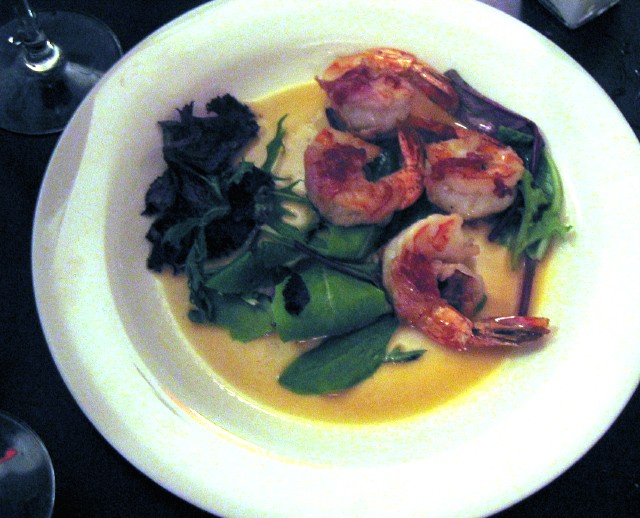
code di gamberi in pancetta

frittelle di fontina con spinaci saltati
(hardly visible, I know)
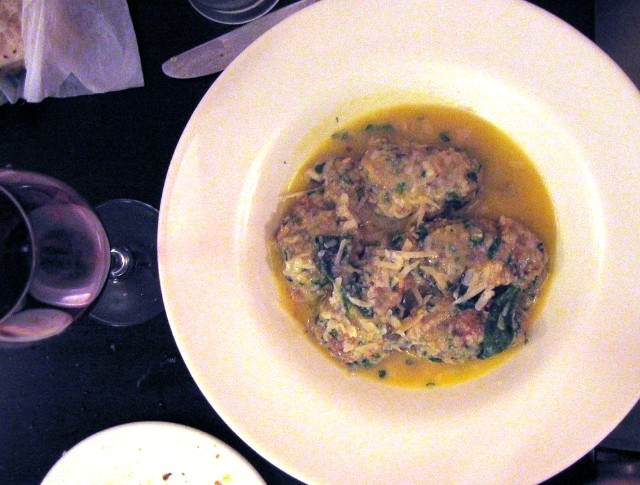
strangolopreti al pan grattato

bigoli con l'anatra
(photographed using my famous "shaking hand" technique)
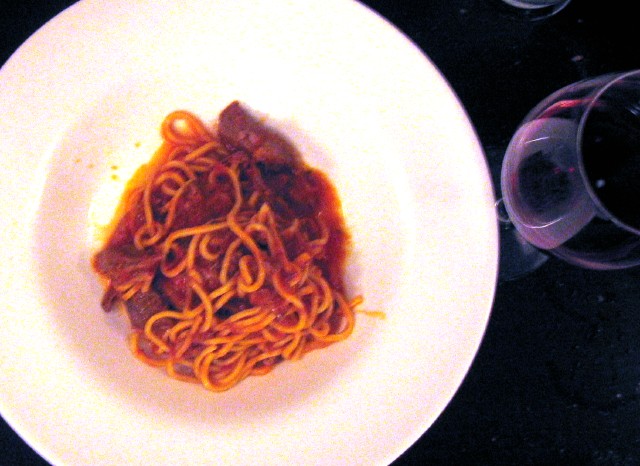
spaghetti alla chitarra con ragu' d'agnello
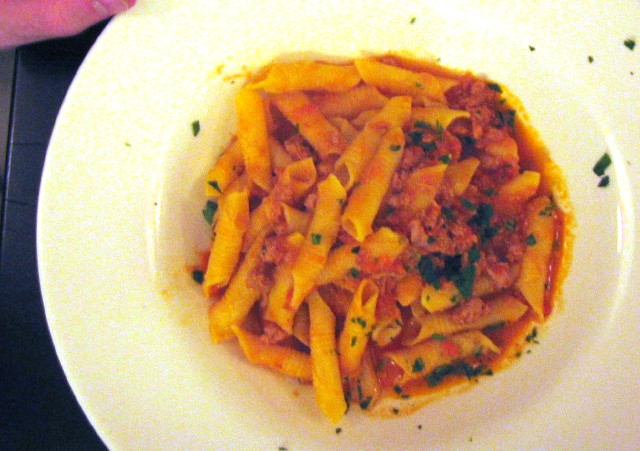
garganelli al ragu' di vitello
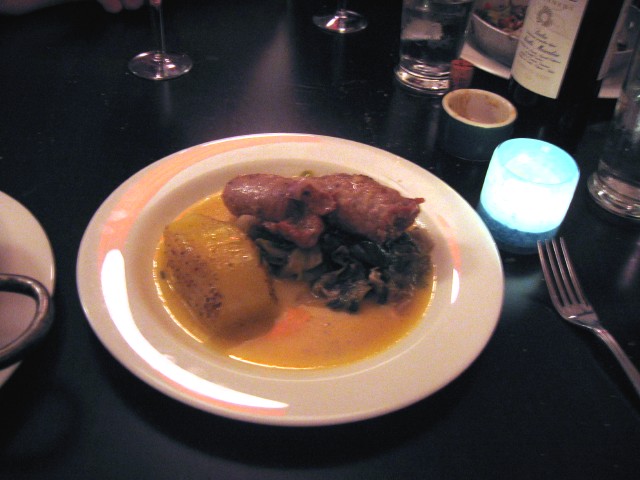
involtini di vitello
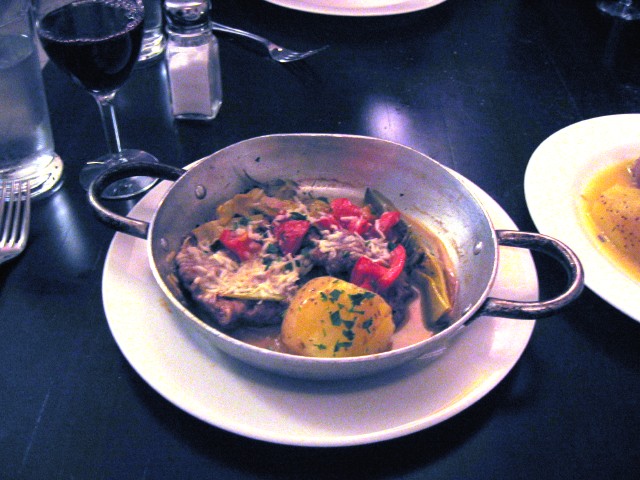
scallopine d'agnello gratinato
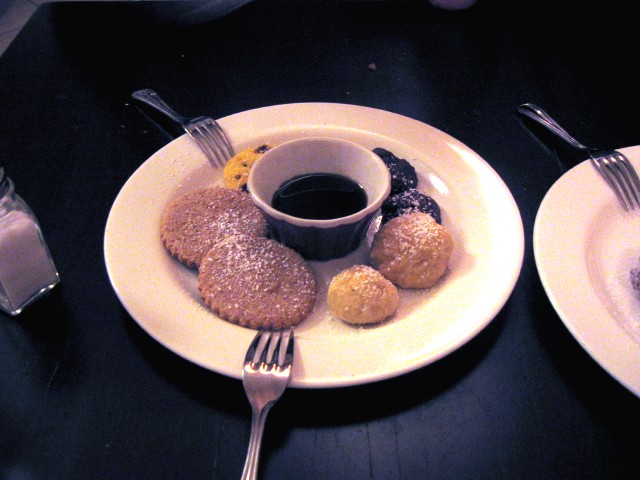
biscotti regionali
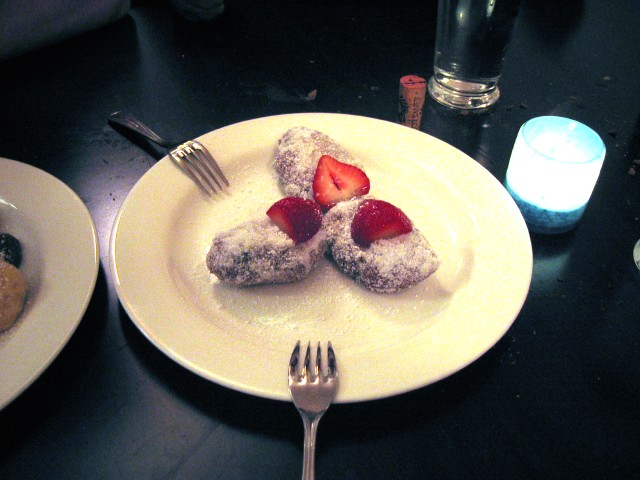
frittelle di ricotta
-
Hey, if the establishment in Oregon won't provide the people with freedom of booze, I say stick it to the Man and order from out of state!
-
How does the Caipirinha's alcohol ingredient, Cachaca, get classified in here? Is it something completely different? What about Aguardiente?
It's hard to say what the difference is, exactly, other than style of fermentation and distillation.
Despite what importers and makers may want you to believe, cachaça, strictly speaking, is rum. After all, what is "rum?" Rum is a distilled spirit derived from sugar cane. It is most often made from molasses, a by-product of the sugar refining process, but is also made from sugar cane juice. The rum that is made from sugar cane juice in the French-speaking Caribbean islands is called "rhum agricole" (agricultural rum). The rum that is made from sugar cane juice in Brazil is called "Aguardiente." To my taste, cachaça and rhum agricole have different characteristic qualities that distinguish them, most likely due to different production methods and goals. Then again, Jamacian rum is different from Cuban rum -- but they're still both rum.
Aguardiente is a little more complicated. The word means simply "firey water" and it is apparently made and understood differently depending on where it is made. In Mexico it can include agave, and in Columbia it is flavored with anise, etc. In the case where it is made from sugar cane, and possibly flavored, it would seem appropriate to call it rum or flavored rum. If the wash contains agave or other fermentables, I'm not sure it would be entirely accurate to call it rum.
For sure there is no substituting aguardiente, cachaça and rhum agricole for one another. Strangely, I've found that the closest thing to cachaça in flavor is a rough pisco, which is made from an entirely different fermentable (grapes).
-
So if one lives in a state still in the dark ages when it comes to alcohol consumption and one wanted to mail order some rhum agricole, what and where would be the best bet?
I think Ed's rhums are finding their way over to the West Coast, or to California at least.
If you can't find any rhum agricole blanc, Barbancourt white from Haiti has many rhum agricole-like qualities and much better availability.
-
I like the Floridita Daquiri. It's a classic. The Papa Doble is another great daiquiri (more or less a double-size Floridita Daiquiri with shaved ice).
-
I've had good success with a drink I've named the Eighteenth Century Cocktail. You also can't go wrong with a rum julep, and I like a good Rum Swizzle. My summer favorite so far has got to be the Ti Punch Ed Hamilton introduced me to.
-
Looking for something new? Try a Ti Punch. I'm sure Ed Hamilton will have something to add with respect to the history and provenance of this drink, but it couldn't be more simple or more delicious. All it takes is a quarter-sized puddle of sugar cane syrup*, a few ounces of white rhum agricole and a half-dollar sized slice of lime peel off the side of a lime (which will have a tiny bit of fruit on the back side). Mix in a rocks glass and fill with crushed ice. As the ice melts, the wonderful flavor of the rhum agricole, lime and cane syrup evolves, becoming more delicious and refreshing with every sip.
* Sugar cane syrup is easily made by making a very rich simple syrup with dehydrated sugar cane juice from the health food store.
A great rhum drink for the summer, and a lot less fuss than making a mojito. Here's a picture of some Ti Punch we made a few days ago. The rhum agricole is La Favorite, my favorite among the several Ed is bringing into the country from Martinique. It's 100 proof, full of flavor and a bargain at around $30 a liter.
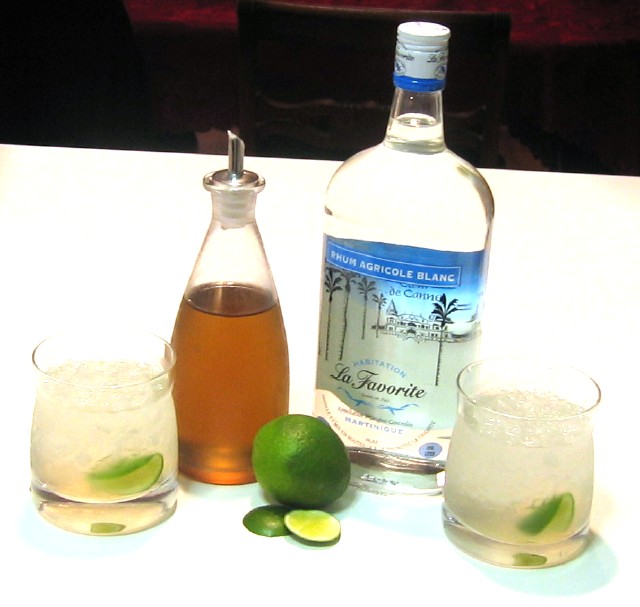
-
 1
1
-
-
Gins have followed in vodka's footsteps (or more likely vodka followed gin) by changing disadvantages into marketing gimmicks. For instance the "gin head", once a cost-saving measure used by gin manufacturers to flavor large amounts of gin with small amounts of botanicals has become a creator of "subtle flavors" for high end gins.
I wonder if you could elaborate on this a bit more. What, exactly, is the "gin head," how is it being used and by whom?
Bourbon makers are busy eating eachother (Maker's Mark just got bought by Jim Beam, I think) but I'm not sure what else has changed besides the higher distillation proofs and lowering bottle proofs.I don't think it's quite accurate to say that Jim Beam purchased Maker's Mark. What happened was that Fortune Brands, a consumer brands parent company that includes such liquor brands as Jim Beam, Vox and The Dalmore under its umbrella as well as brands such as Master Lock, Titleist and Swingline, received approval from the European Commission to acquire Maker's Mark, along with other brands such as Sauza, Courvoisier and Larios, from both Allied Domecq (Maker's Mark, Beefeater, Canadian Club, Stolichnaya, Perrier Jouët, Clos du Bois, Dunkin Donuts, Baskin Robbins, etc.) and Pernod Ricard (Wild Turkey, Jameson, Bushmills, Powers, Pernod and Ricard of course, Wyborowa, Martell, Dubonnet, etc.). So its not exactly like the people at Maker's Mark are suddenly going to be taking their orders from Jim Beam's management or running their whiskey out of Jim Beam stills. In fact, Jim Beam and Maker's Mark shouldn't have anything to do with each other whatsoever.
Also, won't they have to change the laws before bourbon producers can monkey around with the distillation proofs and bottle proofs much more than they already have? As far as I know, "straight whiskey" must be distilled from at least 51% of one kind of grain to no more than 80% abv, aged for at least two years at no more than 62.5% abv in charred new oak barrels, and bottled at no less than 40% abv with no neutral grain spirits or any other substances added.
-
Or even simpler, toss the peeled cloves in with the potatoes to cook.
That's what I do as well. Seems to add a nice, mild garlic flavor. If the librarian is a garlic novice, this is what I would recommend. Definitely the easiest thing to do.
I would definitely recommend roasting the garlic too. And - for sheer ease of use - I like those little ceramic garlic roasters.Now I need at least one of these things! Garlic roasters?
Eh. I used to have one but eventually got rid of it. There's nothing simpler than just plopping a head (or several heads, or a handful of peeled garlic) onto a sheet of heavy aluminum foil, drizzling on a little evoo and sea salt, bunching the whole thing up and tossing it in the oven for half an hour. Nothing to clean afterwards, scalable from one clove to several heads of garlic simultaneously, no storage issues.
-
In the course, you mention the "doufeu" variation of the dutch oven. I have been wanting to acquire a dutch oven for braising, stews, etc. I have an opportunity to get an 7 1/4 quart Le Creuset oval doufeu at an extremely good price. I am trying to understand the advantages of this variation over a regular oval or round dutch oven. Do you have any experience with this version? Does the design and the use of ice-cubes and the build-up of condensation under the lid make that much difference in the cooking process?
For those who may be curious, Lisa is talking about this new product from Le Creuset. I don't have any experience in cooking with a doufeau, but the principle seems interesting. Needless to say, this will only work with stovetop cooking and isn't much use for oven braising. I have cooked with the Staub cocotte, which has "basting spikes" on the underside of the extra heavy lid that serve as condensation/dripping points. My somewhat unscientific observation is that foods braised in the Staub cocotte were more tender and moist than those braised in the equivalent Le Creuset. But the Staub design differs from the Le Creuset design in a number of ways (heavier, matte black interior, etc.) so it is impossible to say how much of this was due to the basting action of the lid.
All that said, if you can get the 7 1/4 Le Creused doufeu at a great price, and if your kitchen could use a 7 1/4 oval enameled cast iron cooking vessel, I think you're crazy not to get it. At the very least, it will be just as good as a regular 7 1/4 oval Le Creuset. And it might be better.
Let us know what you think if you end up buying it.
Question: for brand new copper pots, isn't it necessary to remove a coat of varnish that keeps the copper shiny?Yes. Acetone (aka nail polish remover, but available for less money at your local hardware store) is best, but 93% rubbing alcohol from the drug store will do the trick as well.
-
Don't forget Flatiron Lounge, one of the top spots in the City for a drink.
And there are also Sasha Petraske's two other places besides Milk & Honey. There's Little Branch on the West side, with the same meny as M&H but no reservations policy, and there's The East Side Company at Essex and Grand, also with no reservations policy plus a more informal setting and a uniquely different take on the cocktail lounge (all citrus is muddled, focus is on rocks drinks, there are usually several bowls of punch, etc.).
-
There are several ways that proof effects the flavor of a cocktail. You just have to understand a little bit about the way the liquor is made.
When liquor is distilled, it comes out of the still at a certain percentage of alcohol by volume. The higher the % abv, the greater the percentage of straight ethanol and the smaller the percentage of fusel oils, aromatic compounds and all that sort of thing ("congeners"). These congeners are largely responsible for giving the unaged distillate flavor, aroma, mouthfeel, etc. On the other hand, not all of these flavors are very good and some congeners are actively bad for you.
So, we know that an alcohol distilled to a lower % abv is likely to have more flavor/aroma/etc. compared to an alcohol distilled at higher % abv. We also know that the alcohol distilled to the lower % abv might have flavors and other substances in there that we would like to get rid of. One way of getting rid of these unwanted substances is by aging in wood, which absorbs certain undesirable substances and reacts with others to create desirable substances. The wood, of course, adds its own flavors to the distillate.
Different distillers (and different spirits) will use different methods of distillation and distill their spirits to different percentages of alcohol. For aged spirits, a lower distillation % is often a good thing. But when we say "lower distillation %" we're still talking about something north of 50% abv. Some spirits (aka "neutral spirits") are distilled to more than 95% abv and retain very little flavor from the distillation process. This is why very few overproof proof spirits are particularly flavorful. Unless the overproof spirit spends a lot of time in wood, or is otherwise flavored, it doesn't bring much flavor or its own to the table. Even if it spends a lot of time in wood, it's fundamentally getting just about all of its flavor from the wood. People reasonably assert that vodka derrives more flavor from the water used to dillute it to bottle proof (more on this below) than it does from the actual raw ingredients.
In the case of certain spirits (gin, aquavit, etc.) we start with high % abv neutral spirits and flavor them with various substances. Sometimes this will be a straight infusion, sometimes it will be infusion followed by redistillation, sometimes it will be by placing baskets of spices in the neck of the still so the rising vapors are infused with flavor, etc. But the point is that we're taking something that has little flavor and putting flavor into it. At this point, we have an overproof spirit with plenty of flavor.
The final step is to dilute the spirit to bottle proof by adding water. Needless to say, adding water has the additional effect of diluting the flavor of the spirit.
If we start off with freshly-infused gin at 97% alcohol and dilute it down to 80 proof (40% alcohol) we are adding a lot of water. In fact, we have diluted the spirit by more than 50%. That's going to "water down" the flavor of the gin quite a bit. As you may imagine, if we start off with freshly-infused gin at 97% alcohol and dilute it down to 92 proof (46% alcohol) we aren't watering the flavor down as much. In general, the 93 proof gin will have a more emphatic flavor than the 80 proof gin. Similarly, 100 proof whiskey will have more flavor than 80 proof whiskey. This is all verifiable by science, by the way. 101 proof Wild Turkey has a higher concentration of flavor components than 80 proof Wild Turkey.
So, in general, we would like aged spirits like whiskey, brandy and rum to be distilled at low proof, we would like unaged spirits like white rum and silver tequilla to be distilled at medium proof and we would like unaged spirits like vodka and gin to be distilled at high proof. We would like for all of these to be bottled at high proof, because that means that they will have the most flavor (i.e., the least dilution by water). Since we're going to be diluting the spirit with water from melting ice and other nonalcoholic flavorings when making cocktails anyway, we would rather go for the maximum flavor. Also, if you use a higher proof base spirit, it can spend more time with the ice getting colder without watering down. I prefer base spirits at around 100 proof.
One other thing that may not be clear: 50% abv is "proof" -- aka "100 proof." "High proof" generally means "near 100 proof." Spirits that are substantially above 100 proof (e.g., 151 proof) are often referred to as "overproof." While mixing with 151 proof gin might be interesting (keeping that it gets all its flavor by infusion at high proof), noninfused overproof liquors are typically not as flavorful because the most flavorful components have been distilled out of them.
-
"Plastic Lumps?"
-
Channel knives are useful for certain decorative garnishes, such as a horse's neck, but not very good for actual twists. One reason is that they generally take too much pith, but more importantly, they don't tend to carry much citrus oil, and even more importantly, they're almost impossible to actually twist over the cocktail. The twisting action is important to express the citrus oils. A twist of lemon or orange is more than just a visual adornment. The oils that are expressed onto the surface of the drink (and often also rubbed around the rim of the glass) can make a huge impact on the aroma and flavor of the drink.
I used to use the channel cutter part of my zester to make cocktail garnishes, but ended up switching to a peeler because it not only results in a better twist but also is easier to use.



Making Maraschino Cherries
in Spirits & Cocktails
Posted
According to an article in the NY Times magazine a few months ago, the original maraschino cherries were made by marinating Marasca cherries in maraschino liqueur. So, all you need to do is find some sour cherries, pour some maraschino liqueur over them, and wait however long you're inclined to wait.
By the way, the evil red color of modern "maraschino cherries" has nothing to do with the real thing.